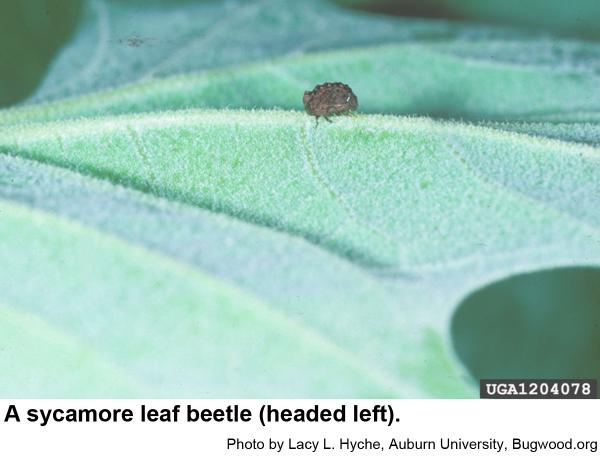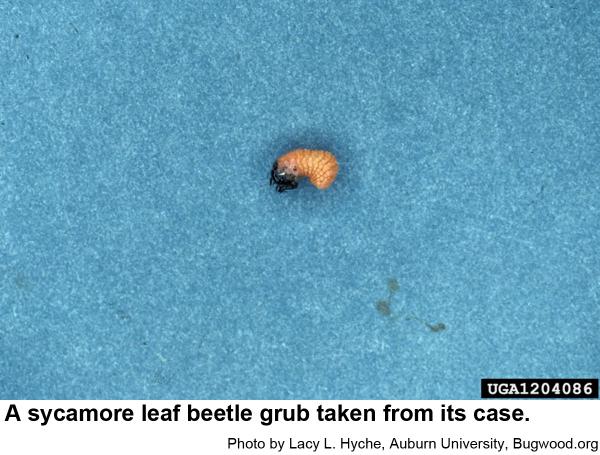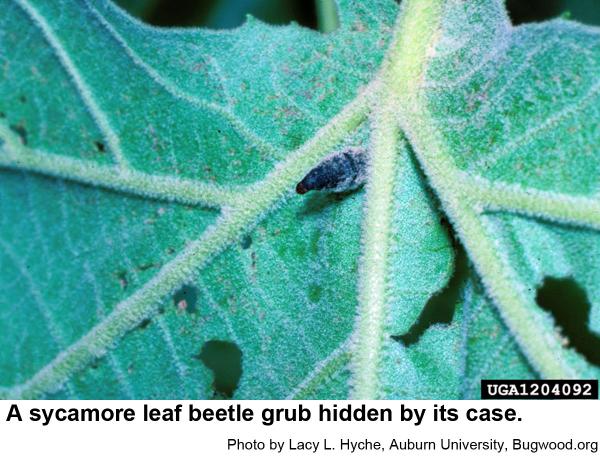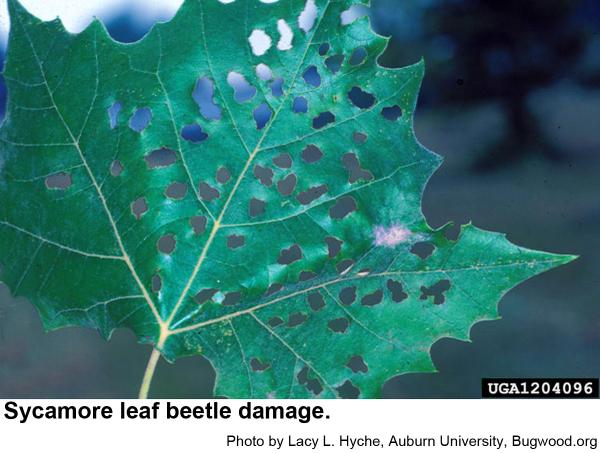Description and Biology
Sycamore leaf beetles, Neochlamisus platani, are case bearing leaf beetles that feed on the leaves of sycamore. The adults are small, chunky, and wrinkled but very attractive bronzy beetles shaped somewhat like a caterpillar dropping. Females lay up to 150 eggs from mid May through June. They encase their orange eggs in fecal material on the under side of leaves (sometimes on top and sometimes on petioles). Orange grubs hatch about two weeks later and feed by chewing small holes all the way through leaves that appear as "shot holes" as the leaf expands. Grubs each construct a case from plant material and recycled plant material (frass) into which they can retreat to molt four times as they grow. The case also provides some protection from predators. When molested, grubs hold tightly to the leaf with their claws and mandibles so that a predator sees only the case. When mature, grubs wander to the leaf stipules and cling there where they resemble buds. There they molt into pupae inside their cases, and from the pupal stages adult beetles emerge some days later.
Host Plants
Sycamore leaf beetles feed only on American and London sycamores as larvae and adults.
Residential Recommendations
Usually more than a third of sycamore leaf beetle eggs are parasitized by an exceedingly tiny wasp, Tetrastichus chlamytis. Should these beetles become abundant enough to warrant control measures, most of the insecticides sold for landscape use in the plant sections of big box stores and in nurseries and garden centers should give more than adequate control. As sycamores are often infested with sycamore lace bugs, treating for sycamore leaf beetles should help control the lace bugs as well.
Other Resources
- Bionomics of Immature Stages and Ethology of Neochlamisus platani (Coleoptera: Chrysomelidae) on American Sycamore. Neal, J. W. Jr. 1989. Annals of the Entomological Society of America 82 (1): 64 to 72.
- Catalog of the leaf beetles of America north of Mexico (Coleoptera: Megalopodidae, Orsodacnidae and Chrysomelidae, excluding Bruchinae). Riley, E. G. et al. 2003. Coleopterists Society Special Publication no. 1. 290 pp.
- Lace Bugs, Frank, S. D. and S. Bambara. 2009 (revised). Entomology Insect Notes. NC State Extension Publications.
- Sycamore Lace Bug. Baker, J. R. 2016. PDIC Factsheets, NC State Extension Publications.
- Extension Plant Pathology Publications and Factsheets
- Horticultural Science Publications
- North Carolina Agricultural Chemicals Manual
For assistance with a specific problem, contact your local N.C. Cooperative Extension Center.
This Factsheet has not been peer reviewed.
Publication date: March 6, 2019
Reviewed/Revised: Dec. 20, 2023
Recommendations for the use of agricultural chemicals are included in this publication as a convenience to the reader. The use of brand names and any mention or listing of commercial products or services in this publication does not imply endorsement by NC State University or N.C. A&T State University nor discrimination against similar products or services not mentioned. Individuals who use agricultural chemicals are responsible for ensuring that the intended use complies with current regulations and conforms to the product label. Be sure to obtain current information about usage regulations and examine a current product label before applying any chemical. For assistance, contact your local N.C. Cooperative Extension county center.
N.C. Cooperative Extension prohibits discrimination and harassment regardless of age, color, disability, family and marital status, gender identity, national origin, political beliefs, race, religion, sex (including pregnancy), sexual orientation and veteran status.





